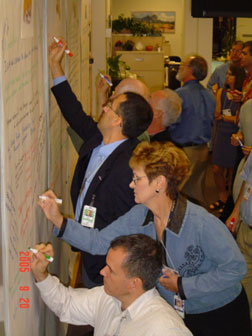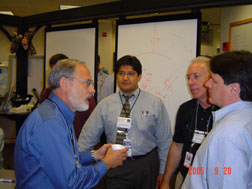NEWS RELEASES
FOR IMMEDIATE RELEASE
October 26, 2005
Future of War Think-Fest produces many sparks
‘Disconcerting’ results call for fewer ‘strikes’ and broader understanding
 Future of War Think-Fest participants write their
ideas on a large white board.
Future of War Think-Fest participants write their
ideas on a large white board. Download 300dpi JPEG image, “future-participants.jpg,” 172K (Media are welcome to download/publish this image with related news stories.)
ALBUQUERQUE, N.M. — Will women’s rights groups fall in the battle against religious extremism? Will the elderly monitor battlefields remotely, viewing monitors that free younger people for other tasks? Will blogs fragment the opinions of conventional media? Will international consortiums form their own armies to protect their properties? And will online banking affect national borders, becoming a primary source of e-globalization, virtual money laundering, and terrorist funding?
These and other informal questions and insights about the world’s future were scrawled on whiteboards or spoken aloud during in a two-day gathering of 49 visionaries with exceptionally varied outlooks, gathered from across the country into the spartan, windowless quarters of Sandia National Laboratories’ Advanced Concept Group (ACG) in late September.
The Advanced Concept Group periodically invites outside experts to “think-fests” that investigate long-range problems that could impact national and global security. Sandia is a National Nuclear Security Administration laboratory.
 ACG leader and Sandia VP and principal scientist
Gerry Yonas (left) discusses ideas with participants.
ACG leader and Sandia VP and principal scientist
Gerry Yonas (left) discusses ideas with participants.
Download 300dpi JPEG image, “acg-leader.jpg,” 252K (Media are welcome to download/publish this image with related news stories.)
The creative thinkers were at Sandia to brainstorm the future of war and peace. There were people from U.S. Special Forces and from conciliation groups. There were social and political and educational theorists. And there were people who know how to blow things up. There were people on third careers after spending decades in the military and people just starting out with degrees from Harvard. Eighteen were Sandians.
“I want you to operate as a collective brain,” said ACG leader and Sandia VP and Principal Scientist Gerry Yonas, as he introduced the Future of War Think-Fest at a get-acquainted dinner at Albuquerque’s National Atomic Museum. “What we’d like to take out of this is one great idea.”
Sandia’s Wendell Jones, who led the ACG exercise, preferred the concept of a farming activity: “We want to plant as many seeds as possible. Some won’t germinate; others will grow.”
ACG member Karl Braithwaite, whose background includes helping write many environmental laws (Clean Air Act, Clean Water Act, Superfund, and others) and serving as Dean of the Edmund S. Muskie School of Public Service at the University of Southern Maine, said, “My colleagues [elsewhere] found it unusual that a nuclear weapons lab in New Mexico would have such far-reaching discussions.”
The approach involved creating four versions of the world as it might exist in 2025: inclusive globalization, pernicious globalization, regional competition, and a post-polar world where everyone works together. While no one conclusion emerged, there were many that could merit further thought.
Among them:
•While in the past, the U.S. had resisted becoming dependent on a single supplier for strategic goods, it is now strategically dependent on China for consumer goods and credit.
•The military will increasingly be concerned with peacekeeping and peacemaking; it will need a negotiating capacity, and a capacity to rebuild.
•There will be “a rise in American humility, an acceptance that we can’t do everything and be everywhere.”
•Get in, get out, with no boots on the ground.
•“We want the world to love us more, while getting all the things we got by being mean.”
• Chinese military R&D funding is smaller than the U.S. but pays its researchers only 1/50 as much, so the amount of research done may be more similiar than it seems.
• Worldwide business consortiums may build their own armies to protect their investments.
• Headline from 2025: “OPEC crashes; Muslims, anti-green terrorists blame U.S., China, EU” [because of fast rise of ‘green’ energy].
• A continental state will be formed of Canada, the U.S., and Mexico, ending our border problems.
• Adding anthropologists and sociologists to the mix of lawyers and military people who currently make most military decisions will provide more insight into what the U.S. will run into in places like Iraq.
Participant Alan William objected, “[Most of] these assumptions are that the U.S. won’t be the dominant military power in 2025. It’s my job to see that it remains so, and I believe that it will.” Williams, an engineer, leads the Georgia Tech Research Institute’s Future Threat Initiative.
Yonas expressed disappointment that he “came out with what I went in with,” and “did not get that big idea.”
“We already knew that the military will not provide the solution to the ideological wars of the future,” he said afterwards. “The meeting participants agreed. Little came out that said war does anything for you in these fundamentally ideological wars. If there is no superpower to confront, and Islam is having a war of ideas within itself, trying to find its way, then we have to rethink the role of the military and the tools it needs. Instead of the ‘Big Army’ solution, what we may need is the small forces approach we used in Afghanistan. Preventing conflict far in advance of possible future disputes may be the most effective approach.
“Rather than ‘walk softly and carry a big stick,’ the meeting concluded it’s better to listen to your enemies carefully and carry a small stick, or maybe lots of small very precise sticks. If the future is Special Forces and low-intensity conflict, the technology that is critical is predictive awareness: a persistent, ubiquitous network of smart sensors. This may need to be coupled to precision strike and precision understanding of the strike.”
The program also took criticism from some participants who disagreed with the choice of context.
Stewart Brand, compiler of the Whole Earth Catalog (which won a National Book Award) and a former infantry lieutenant, e-mailed after the meeting’s conclusion: “Most of our recommendations seemed appropriate [only] for an audience of the Joint Chiefs and a bipartisan Congressional commission, since they had to do mostly with reorganizing the nation’s military/intelligence apparatus.”
Former Naval Special Warfare Office Kevin Baugh, now associate director of the Office of Government and industry liaison for the Biodesign Institute at Arizona State University, e-mailed that he “was very pleased with what I got out of the [conference but] . . . I was especially disheartened by the fact that we did not exercise a truly difficult scenario (perhaps something like a post nuclear war in the Mideast world) where much of the world’s oil supply becomes contaminated unexpectedly and the U.S. must suddenly cope with real shortages in petroleum products in a highly competitive world.”
Of the alternative scenarios posed, Sandia think-fest organizer Wendell Jones said, “That’s the point of the diversity of the group. Some participants were way out of their comfort zone and others thought we weren’t way out there enough. We could have created a list of scenarios to energize [the more radical participants] but we would have had zero traction to energize national security folk.
“We wanted plenty of people in this crowd — like the Grummans and the Boeings and the military services — prejudiced to want some potent technology that could prevail in the future. Then we wanted social science people who would contend for more artful, sophisticated influence. Interestingly, we didn’t have knockdown fights between social scientists and military folks. Everybody came out and said we have to get much smarter in understanding cultures and influencing ideas, and gain technology to influence people’s motives and intentions,” Jones added.
“It was a disconcerting conclusion. Many of the folks there would have been happy to have a mission come rolling out [to take the technology and make it overwhelming for the U.S.], but that’s not what came out from any group, despite the military/DOE presence. The Fest seemed to say, wow, maybe the future of national security is all around these other features,” said Jones.
“We’re still discussing [in the ACG] what that means for Sandia’s future,” he said.
Many participants expressed interest in remaining in contact with each other for further discussions on any of 12 general topics — like the importance of education, or the effect of neuroscience — discussed at session’s end. A contact list was provided to each participant.
Said Jones, “One of our aims was to bring people together who would otherwise never run into each other in their daily lives. I think we did that. Three genuinely diverse collaborations seem already to have sprung up. We’re looking forward to seeing how many more idea-seeds sprout.”
Sandia is a multiprogram laboratory operated by Sandia Corporation, a Lockheed Martin company, for the U.S. Department of Energy’s National Nuclear Security Administration. Sandia has major R&D responsibilities in national security, energy and environmental technologies, and economic competitiveness.
Sandia media contact: Neal Singer, nsinger@sandia.gov, (505) 845-7078